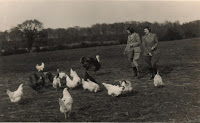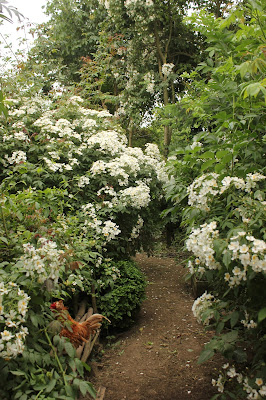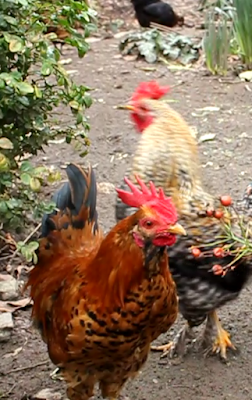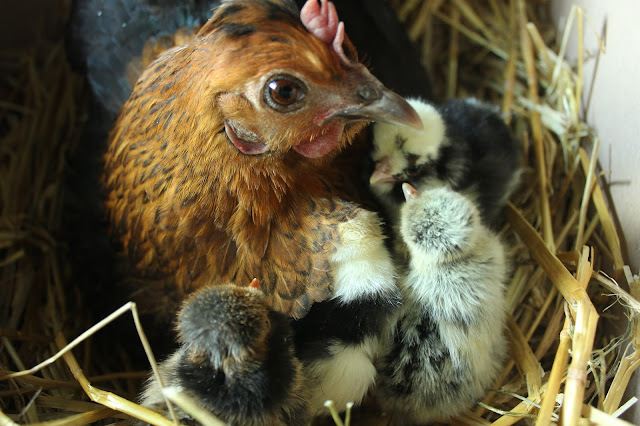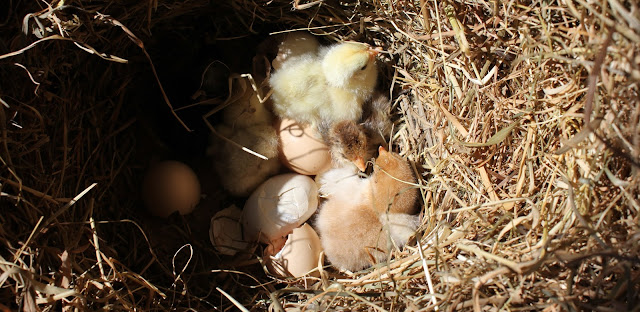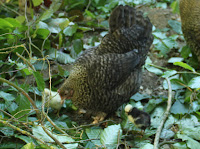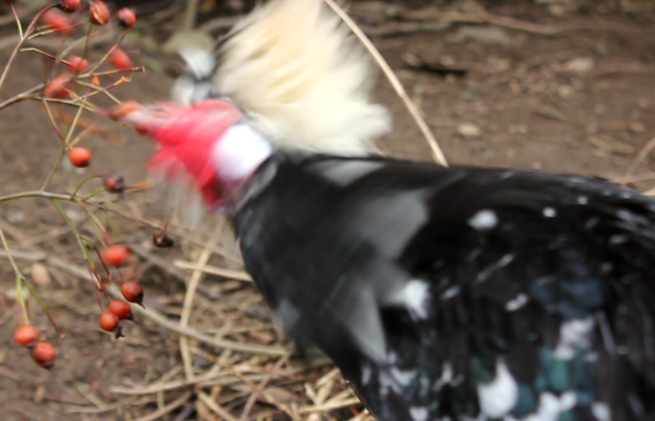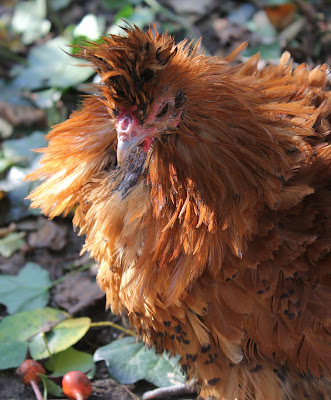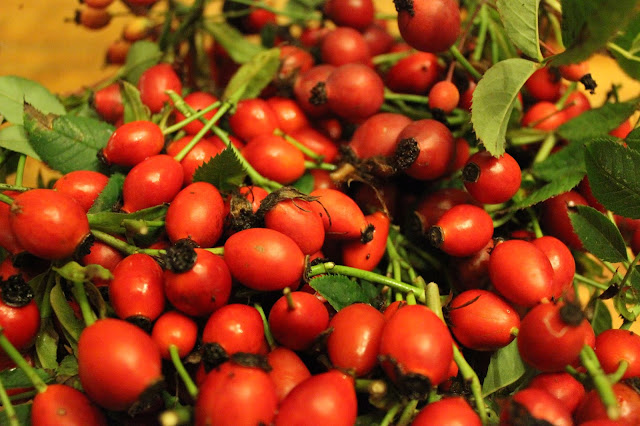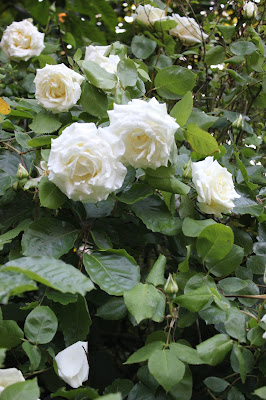In the first part of this article, which can be found here, we looked at a breakdown of the nutritional content of these two amazing foods from the prolific rose (see as an example, rosa filipes Kiftsgate below left). In this article I'll share why our poultry can benefit from this all-year-round food-crop with a wealth of vitamins, minerals and phytochemicals to keep themselves in the best of health and beauty.
Rose Hips and Leaves - Why our poultry need the nutrients they offer
Vitamin A (Retinol) precursor: beta-carotene
- is important not only as in humans for the health of
eyes, skin, normal growth and development and the transport of Calcium
to the bones but also for shell quality. Without sufficient vitamin A,
calcium is deposited in the soft tissue thus risking heart conditions
and skeletal problems. Beta-carotene
also, has strong antioxidant properties and can protect your birds from many
potential conditions associated with free-radicals. Vitamin A deficiency
also causes keratosis (see my article here), which encourages the proliferation of external parasites. Also see under Zinc for its role in the transportation of Vitamin A
Vitamin C (L-ascorbic acid) Sometimes known as the 'grandfather of traditional antioxidants' and thus involved in maintaining optimum electron flow in the cells. In my experience it is the 'go to' vitamin an adult bird will consume when under stress and incidentally it is the first one to be depleted. Vitamin C is also responsible for the better absorption of Iron, necessary for growth particularly in the young and active chick. It is also essential for collagen synthesis, thus important for the structure of the bones, blood vessels, tendons and ligaments. I like to give my birds oyster shell because I think this enables them to adequately judge for themselves how much they are taking in. I am also aware that wild birds use snail shells and other potentially calcium rich sources, such as calcareous grit to provide this mineral in their diets. However, plant sourced calcium was found in a study: Nutrition and Feeding of Organic Poultry (Blair 2008) to be as bioavailable to poultry as that of the usual sources of limestone and oyster shell.
Vitamin E is made up of eight compounds (Tocopherol/tocotrienols) it has
antioxidant properties and is important for growth and nervous system
recovery in times of stress. It has also been shown to have significant
impact upon fertility in poultry, in both sexes and upon the hatchability
and general health of the chicks. Vitamin E is crucial in protecting eye
and brain health and helps the body utilise Vitamin K.
Vitamin K1 (Phylloquinone) is found primarily in plants and has a role in the transport of Calcium to the bone and thus in quail and other poultry to the formation of shell. If Calcium has formed in the soft tissue (arterial calcification) both phylloquinone and to a greater extent menaquinone (Vitamin K2), have the ability to reverse it. Vitamin K1 goes directly to the liver and is well known for its ability to help to clot the blood and avoid blood loss. It is also important for nerve impulse transmission and muscle co-ordination.
Phosphorus is important for a whole raft of physical and nervous system function. Plant-based phosphorus is often conjectured to be less bioavailable because it is bound with phytates. To me, this seems relevant only in the seed and grain form, which is understandable as the plant is protecting its 'offspring' from being digested. My conjecture would be that within the leafy plant itself, particularly one where the fruits are meant to be consumed to disperse the 'hairy' seed (obviously to be excreted intact), phytates would not be an issue. Phosphorus is also linked with bone density and the transport of Calcium, thus in poultry with the formation of shell and hatchability of the chicks. Chicks deficient in phosphorus may also have soft beaks and bones (rickets).
Zinc Is required for normal protein synthesis and metabolism and is also a component of a number of enzymes such as carbonic anhydrase, which is essential for eggshell formation in the shell gland. Other important zinc enzymes in the bird include carboxypeptidases and DNA polymerases. These play important roles in immune response, in skin and wound healing and hormone production. Zinc also has a role in the transportation of Vitamin A from storage in the liver for use in the rest of the body. Zinc deficiency in the parent bird will also cause a prevalence of low hatchability and the self-explanatory condition known as 'dead in shell'. Birds deficient in zinc also exhibit 'frayed' feathers. Zinc deficiency also impacts on feather pigmentation in certain colours of plumage.
Phytochemicals Phenolic compounds have antioxidant, antimutagenic and anticarcinogenic effects. Antioxidants delay the aging process and to the decrease of the inflammation and oxidative stress risk, related to chronic disease.
Until next time, all the very best from sunny Normandie!
© 2021 Sue Cross
RELATED ARTICLES
Food for Free Fabulous Forage Part 6 Rose Leaves and Hips
For thousands of years the rose, hips, leaves and blossoms have been used as medicinals for both physical and nervous system ailments. .....read more
Food for Free. Fabulous Forage Part 5 Rose Petals
One of the main roses I use for both cooking, medicinals and which my hens very much enjoy is, not surprisingly, rosa gallica Officinalis, or The Apothecary Rose... read more
Quail, Chickens & Watercress - A winning combination
Quail, Chickens & Watercress Part 2 - Cultivation & Harvest
Contrary to its common name nasturtium officianale does not need to be grown in water, moist soil is fine. However, it does give the watercress...read moreNutrient from the Sun - How Poultry Obtain and Make Vitamin D₃
Providing Forage for Organic Poultry Part 1
Providing Forage for Organic Poultry Part 2
Continuing an in-depth look into forage and discussing the what, when, where from and why...read more